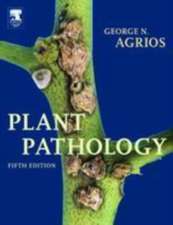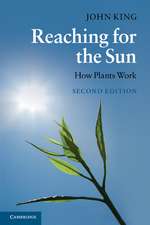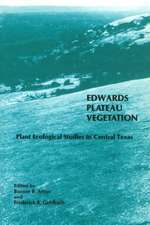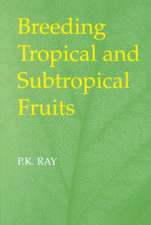Reproductive Physiology in Plants: Research Progress in Botany
Editat de Philip Stewart, Sabine Globigen Limba Engleză Hardback – 15 apr 2011
In horticulture, agriculture, and food science, plants’ reproductive physiology is an important topic relating to fruits and vegetables, the main consumable parts of plants. All aspects of plant physiology, including plants’ reproductive systems, are important to the production of food, fibers, medicine, cosmetics, and even fuels. This volume presents many new studies on plants’ reproductive systems, including new research on sperm cells in plant reproduction; the effect of herbivory on plant reproduction; disturbances to functional diversity; plant genes, hormones, DNA; and much more.
| Toate formatele și edițiile | Preț | Express |
|---|---|---|
| Paperback (1) | 493.61 lei 43-57 zile | |
| Apple Academic Press Inc. – 31 mar 2021 | 493.61 lei 43-57 zile | |
| Hardback (1) | 770.26 lei 43-57 zile | |
| Apple Academic Press Inc. – 15 apr 2011 | 770.26 lei 43-57 zile |
Preț: 770.26 lei
Preț vechi: 1030.96 lei
-25% Nou
Puncte Express: 1155
Preț estimativ în valută:
147.39€ • 154.30$ • 121.95£
147.39€ • 154.30$ • 121.95£
Carte tipărită la comandă
Livrare economică 07-21 aprilie
Preluare comenzi: 021 569.72.76
Specificații
ISBN-13: 9781926692647
ISBN-10: 1926692640
Pagini: 342
Ilustrații: 76
Dimensiuni: 156 x 234 x 25 mm
Greutate: 0.79 kg
Ediția:1
Editura: Apple Academic Press Inc.
Colecția Apple Academic Press
Seria Research Progress in Botany
ISBN-10: 1926692640
Pagini: 342
Ilustrații: 76
Dimensiuni: 156 x 234 x 25 mm
Greutate: 0.79 kg
Ediția:1
Editura: Apple Academic Press Inc.
Colecția Apple Academic Press
Seria Research Progress in Botany
Public țintă
Academic and PostgraduateCuprins
A Plant Germline-Specific Integrator of Sperm Specification and Cell Cycle Progression. Effects of Herbivory on the Reproductive Effort of 4 Prairie Perennials. Identification of Flowering Genes in Strawberry, a Perennial SD Plant. Changes in Tree Reproductive Traits Reduce Functional Diversity in a Fragmented Atlantic Forest Landscape. Genetic Subtraction Profiling Identifies Genes Essential for Arabidopsis Reproduction and Reveals Interaction Between the Female Gametophyte and the Maternal Sporophyte. Arabidopsis WRKY2 Transcription Factor Mediates Seed Germination and Postgermination Arrest of Development by Abscisic Acid. DNA Methylation Causes Predominant Maternal Controls of Plant Embryo Growth. Gibberellin Acts through Jasmonate to Control the Expression of MYB21, MYB24, and MYB57 to Promote Stamen Filament Growth in Arabidopsis. Expressions of ECE-CYC2 Clade Genes Relating to Abortion of Both Dorsal and Ventral Stamens in Opithandra (Gesneriaceae). A Comparative Analysis of Pollinator Type and Pollen Ornamentation in the Araceae and the Arecaceae, Two Unrelated Families of the Monocots. Life History Traits in Selfing Versus Outcrossing Annuals: Exploring the ‘Time-Limitation’ Hypothesis for the Fitness Benefit of Self-Pollination. Functional Diversity of Plant–Pollinator Interaction Webs Enhances the Persistence of Plant Communities. How to Be an Attractive Male: Floral Dimorphism and Attractiveness to Pollinators in a Dioecious Plant. Pollen Development in Annona cherimola mill. (Annonaceae). Implications for the Evolution of Aggregated Pollen. Distinct Short-Range Ovule Signals Attract or Repel Arabidopsis Thaliana Pollen Tubes In Vitro. Index.
Notă biografică
Dr. Philip Stewart has a PhD in horticulture with a focus on the genetics of flowering in strawberries. He has worked in association with Cornell University’s Grapevine Breeding Program, the Department of Horticulture at the University of Arkansas in Fayetteville, and the Horticultural Sciences Program at the University of Florida in Gainesville. He has contributed to multiple publications, including the International Journal of Fruit Science, Horticultural Science, Plant Science, and BMC Plant Biology. He has served as a member on the U.S. Rosaceae Genetics and Breeding Executive Committee, the North American Strawberry Growers’ Association, and the Small Fruit Crop Germplasm Committee. Dr. Stewart is one of the inventors of the patented strawberry plant named DrisStrawSeven, and he currently works with the NCRA, State Agricultural Experiment Station Directors.
Professor Sabine Globig received her BA in 1972 at the American University School of International Service and her MS in horticulture and plant physiology in 1988 at Rutgers University, the State University of New Jersey. Presently, she is Professor of Biology at Hazard Community & Technical College in the Appalachian Mountains of eastern Kentucky, where she specializes in human anatomy and physiology and plant sciences. She has also worked as an Adjunct Instructor of Biology at Union County College in New Jersey and at Rutgers University, as well as a certified high school biology teacher. While at Rutgers, she worked as a plant physiology researcher at their AgBiotech Center and held the same position for DNA Plant Technologies Corporation. She has given presentations at XXII International Conference on Horticultural Science, UC Davis, California, 1987; and 1997 International Society for Horticultural Science’s International Symposium on Artificial Lighting in Horticulture, Noordwijkerhout, Netherlands. She has also been included in several Who’s Who entries.
Professor Sabine Globig received her BA in 1972 at the American University School of International Service and her MS in horticulture and plant physiology in 1988 at Rutgers University, the State University of New Jersey. Presently, she is Professor of Biology at Hazard Community & Technical College in the Appalachian Mountains of eastern Kentucky, where she specializes in human anatomy and physiology and plant sciences. She has also worked as an Adjunct Instructor of Biology at Union County College in New Jersey and at Rutgers University, as well as a certified high school biology teacher. While at Rutgers, she worked as a plant physiology researcher at their AgBiotech Center and held the same position for DNA Plant Technologies Corporation. She has given presentations at XXII International Conference on Horticultural Science, UC Davis, California, 1987; and 1997 International Society for Horticultural Science’s International Symposium on Artificial Lighting in Horticulture, Noordwijkerhout, Netherlands. She has also been included in several Who’s Who entries.
Recenzii
"Reflects the most recent research progresses in plant reproductive physiology. It serves as a timely ‘must-have’ collection of papers for anyone interested in angiosperm reproductive biology."
—Shucun Sun, Center for Ecological Studies, Chengdu Institute of Biology, Chinese Academic of Sciences, Chengdu, China, in The Quarterly Review of Biology
—Shucun Sun, Center for Ecological Studies, Chengdu Institute of Biology, Chinese Academic of Sciences, Chengdu, China, in The Quarterly Review of Biology
Descriere
This title includes a number of Open Access chapters.
In horticulture, agriculture, and food science, plants’ reproductive physiology is an important topic relating to fruits and vegetables, the main consumable parts of plants. All aspects of plant physiology, including plants’ reproductive systems, are important to the production of food, fibers, medicine, cosmetics, and even fuels. This volume presents many new studies on plants’ reproductive systems, including new research on sperm cells in plant reproduction; the effect of herbivory on plant reproduction; disturbances to functional diversity; plant genes, hormones, DNA; and much more.
In horticulture, agriculture, and food science, plants’ reproductive physiology is an important topic relating to fruits and vegetables, the main consumable parts of plants. All aspects of plant physiology, including plants’ reproductive systems, are important to the production of food, fibers, medicine, cosmetics, and even fuels. This volume presents many new studies on plants’ reproductive systems, including new research on sperm cells in plant reproduction; the effect of herbivory on plant reproduction; disturbances to functional diversity; plant genes, hormones, DNA; and much more.














